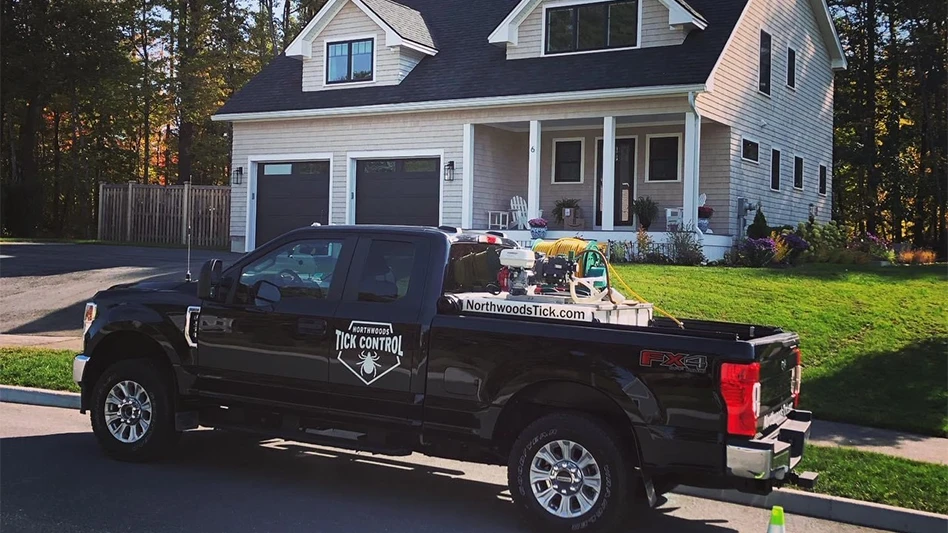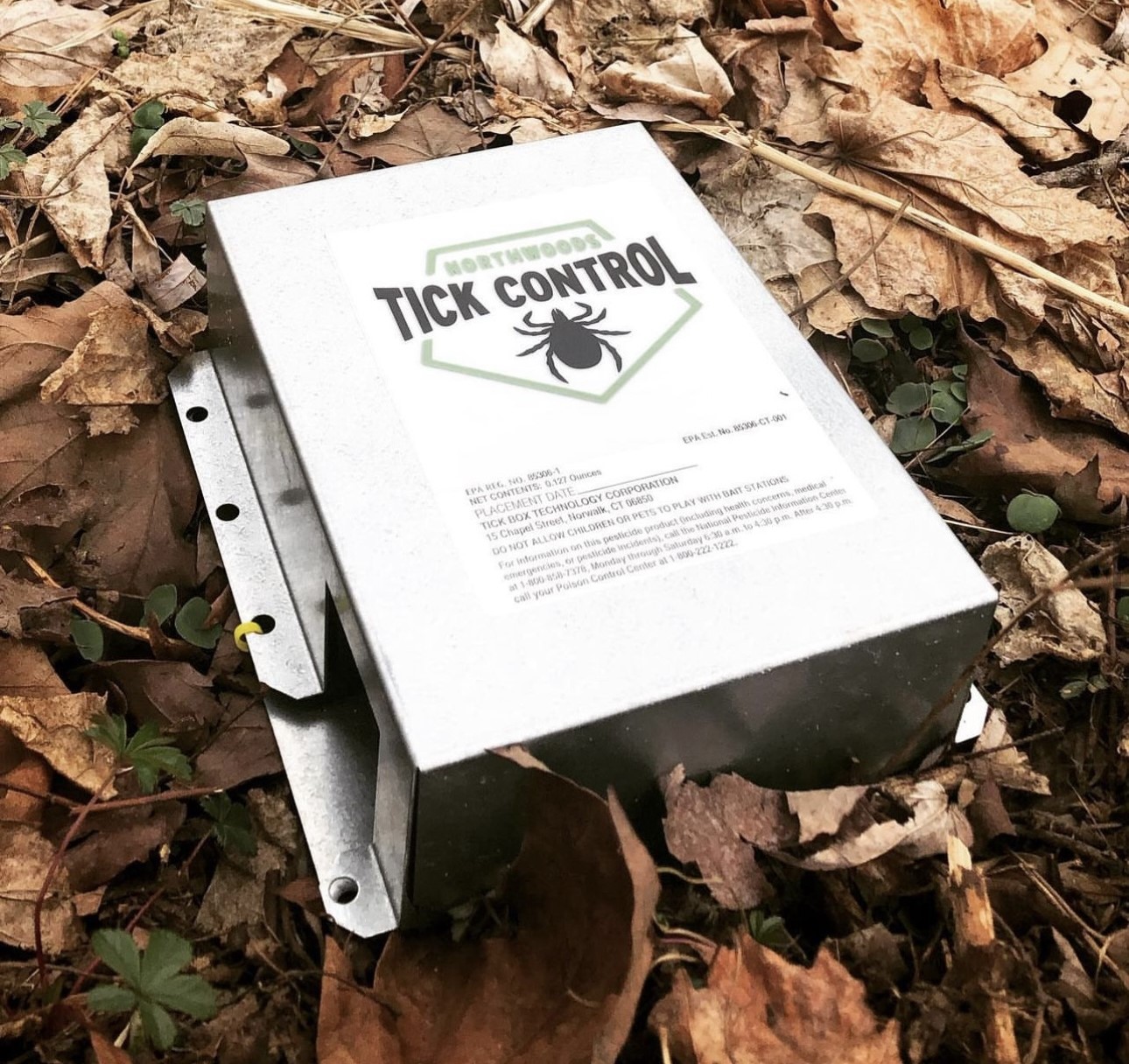
Courtesy of Jon Cole
After a 12-year health scare, which included multiple misdiagnoses and surgeries, Jon Cole started Northwoods Tick Control, Cumberland Center, Maine, in hopes of saving even one person from going through what was a life-changing Lyme disease diagnosis for him.
In 2000, while living in the southern Maine town of North Waterboro, which Cole said is “like the bullseye for ticks in the Northeast,” Cole returned from an afternoon bike ride. While he was getting ready for work as a television news photojournalist, he pulled a peculiar bug off the back of his neck.
At the time, with not a lot of education on what a tick looked like, Cole pulled it off his neck and went about his day. He then experienced a neckache and backache for a few weeks and decided to call his doctor, who prescribed amoxicillin for what was perceived as a viral infection.

It gradually got better, but Cole said he remembers “living off Advil in his late 20s.”
“A few years later, my left knee swelled up to the point where I was really struggling to walk, and I went to go see an orthopedic doctor,” he said. A surgery was scheduled to tap and drain the fluids. Although successful, six months later, the pain came back, he said.
Cole took multiple Lyme disease tests at his primary physician’s office that all came back negative. Before testing positive for Lyme disease in 2012, he was told his diagnoses could possibly be peripheral neuropathy, multiple sclerosis, chronic fatigue syndrome or lupus. Rather than taking any medications, he went strictly vegetarian. It was helpful short-term, but he was losing energy and experiencing more fatigue.
Cascading pretty quickly, Cole’s physical and mental health were on the line.
“They put me out on short-term disability at the TV station, so I wasn't working,” he said. “I was at home, and it was just really depressing.” While in therapy, Cole discovered a naturopathic doctor who conducted a more in-depth screen for Lyme.
Sure enough, he tested positive.
“I was on antibiotics for almost two and a half years straight. I got better about a year into it,” he said. Cole was struggling with everyday parenting duties, including playing with his young daughter.
On the mend to a healthier, happier life, Cole started to wonder, if this severe outbreak could happen to him, what could be done to protect his family, friends and community?
Cole started reading anything he could get his hands on about tickborne diseases and infections. When he went back to work as a photojournalist, his primary interest was reporting on ticks and doing as many stories as possible about Lyme disease.
Learning more about Integrated Pest Management (IPM) through treatment of his own yard and helping family and friends treat their properties, Cole left television to work for a pest control company, creating “significant growth across the board,” he said. “We did more social media content, created viral videos and shared more educational information.”

After a short time, Cole decided to start his own company, Northwoods Tick Control, beginning by creating a website and other strategies for building a customer base. He started using his contacts at the television stations to spread the word about tick-related diseases and identification.
To his surprise, Cole treated nearly 100 properties in his first year. Now in his third year of business, he has more than 400 customers and had to put a cap on accepting service calls in 2023, he said.
This growth is in line with what other PCOs are reporting. In PCT’s 2023 State of the Tick Control Market report, 34 percent of respondents said that tick control services are more significant to their businesses today than over the past five years. That compares with 26 percent who said the same in 2022.
While many PMPs point to changing weather patterns — namely, warmer winters that don’t kill off tick populations as they have historically — others attribute growing tick pressure, and its resultant business, to urbanization, according to the report.
One important factor that figures into the tick equation: public concern related to tick-borne diseases. According to the Centers for Disease Control and Prevention, recent estimates suggest that about 476,000 people may get Lyme disease each year in the U.S., while there were only 17,000 reported Lyme disease cases in 2000, the same year Cole had his encounter with a tick.
These numbers drive Cole to continue sharing educational, consumable content that moms, dads and pet owners will find clickable and shareable to spread the word on tickborne diseases, he said.
“Customers will see me almost as if the kids see Santa Claus, they’re just so happy,” Cole said. “I’ve taught classes on how to effectively treat for ticks while being minimally invasive.”
Two-thirds (67 percent) of PMPs reported that their customers consider ticks a threat to public health; nearly three-fourths (74 percent) said customers recognize ticks can be dangerous to their pets, according to the PCT report. This concern often triggers calls for service, which drives tick control business throughout the season or, in some regions, the year.
TREATING PROPERTIES, EDUCATING CUSTOMERS. Northwood’s treatment protocols follow the two-year lifecycle of ticks, specifically blacklegged ticks, and interrupting the lifecycle, Cole said. A landscape design plan is built for each customer as “each property owner is very unique and has their own ideals, hopes and purposes,” he said.
Northwood’s treatment and product usage at commercial properties will not be the same at residential homes, Cole said, noting he takes environmental factors and other pests, like bees, into consideration when using certain products.
“I have properties where they have commercial beehives where they have six to eight beehives that are active, so spraying a [pesticide] in their yard is probably going to do more damage than good,” he said. “In that particular property, I use a [product] non-toxic to bees when dry.”
In the Tick Control Market report, nine percent of PMPs used tick boxes to manage ticks last year. Cole’s hope is for other PMPs to start using tick boxes as more pesticides may be phased out in Maine in the coming years through the Maine Board of Pesticide Control, he said.
“I hope other PMPs see what I do and try to use other tools, whether it be the tick box, or perimeter vacuuming, removing that habitat, getting it out of that property and taking it away,” he said. “Those tools work, and there’s science behind them.”
Cole said the infection rate of blacklegged ticks is upward of 70 percent in the midcoastal region and 50 percent across the state of Maine. He believes a longer-term solution, like landscape modification and tick boxes, are probably the next big bridge for the future of tick control.

Blacklegged and American dog ticks are the two most common species in Maine, with a combined collection of more than 5,000 ticks reported, according to The University of Maine Cooperative Extension Tick Lab 2022 annual report. Maine also faces threats related to invasive tick species, including the lone star tick and Asian longhorned tick. Both have shown impacts on the health of humans, wildlife and domestic animals.
Cole offers free tick identification services to people who come across a tick and are unsure how to dispose or remove it. He has them take a picture looking from the top of the insect down and text it to him. Within minutes, he’ll be able to identify and instruct them how to safely dispose of it.
“It’s that kind of information that I think is invaluable for people, because so many people want to remove the tick as fast as possible and throw it away or flush down the toilet just to get rid of it,” Cole said.
While both blacklegged tick adults and nymphs can transmit pathogens, the nymphs play an important role in the disease transmission cycle due to their small size and ability to go unnoticed while feeding, as noted in the tick lab report. Adult blacklegged ticks are most active from spring to late fall, with two peaks, one in April or May and another in late October or early November.
In Cumberland County, Cole’s service area, of the 523 blacklegged ticks tested for Lyme, Anaplasma and Babesia at the UMaine Extension Tick Lab, 45 percent of those tested positive for Lyme.
Cole said around those peak season times, he is everyone’s best friend.
“I can't shake enough hands,” he said. “I talk to customers face-to-face and meeting one-on-one with people to help them understand that you’re not 100 percent [safe]. You're still going to have to be vigilant, and the treatment doesn’t travel with you.”
THE FUTURE OF BUSINESS. Many of Cole’s customers are moving towards tick boxes and perimeter landscape work because it's better for the environment and “preserving the value of the state’s beauty,” Cole said.
Twenty-seven percent of PMPs surveyed in the State of the Tick Control Market report the use of green/25(b) exempt products — e.g., botanical sprays and essential oils — to manage ticks in 2023.
“It is certainly effective, and you're taking a rifle approach to tick management as opposed to a shotgun approach. These tick boxes target that vector for Lyme disease,” he said. “We can't have synthetics in the waterways, streams or rivers. It’s simply not acceptable in the state of Maine.”

Luckily for Cole, he continues to use his photojournalist background to shoot educational commercials where he interviews, edits and uploads content to have marketing materials for his business. He’s also done a handful of geofenced paid ads with little financial investment to have seen a successful ROI.
“It was remarkable to hear that even after spending $200 on an ad, people would literally say ‘I see you everywhere,’ and I only have one truck. People thought that I was this ginormous company,” Cole said.
Looking five years ahead, Cole said he would be happy staying at the pace he is working now — keeping a small, in-town route, having one-on-one relationships with customers and creating visual, educational tick content for the community he calls home.
“I really don’t have a whole lot more that I would want, other than newer technology to come out and to make it easier for people to understand tick habitat,” he said. “I would love to be able to use all tick boxes and perimeter vacuums; that would be perfect. Customers seem to be very happy with that and are able to maintain that level of reduction in tick populations.”
Latest from Pest Control Technology
- Donny Oswalt Shares What Makes Termites a 'Tricky' Pest
- Study Finds Fecal Tests Can Reveal Active Termite Infestations
- Peachtree Pest Control Partners with Local Nonprofits to Fight Food Insecurity
- Allergy Technologies, PHA Expand ATAHC Complete Program to Protect 8,500 Homes
- Housecall Pro Hosts '25 Winter Summit Featuring Mike Rowe
- Advanced Education
- Spotted Lanternflies, BMSBs Most Problematic Invasive Pests, Poll Finds
- Ecolab Acquires Guardian Pest Solutions





